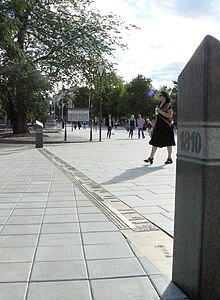
Back التسلسل الزمني Arabic Vaxt qrafiki Azerbaijani কালানুক্রমিক ঘটনাক্রম Bengali/Bangla Línia de temps Catalan Časová osa Czech Zeitleiste German Eje cronológico Spanish Denbora lerro Basque گاهشمار Persian Aikajana Finnish
This article needs additional citations for verification. (January 2018) |


A timeline is a list of events displayed in chronological order.[1] It is typically a graphic design showing a long bar labelled with dates paralleling it, and usually contemporaneous events.
Timelines can use any suitable scale representing time, suiting the subject and data; many use a linear scale, in which a unit of distance is equal to a set amount of time. This timescale is dependent on the events in the timeline. A timeline of evolution can be over millions of years, whereas a timeline for the day of the September 11 attacks can take place over minutes, and that of an explosion over milliseconds.[2] While many timelines use a linear timescale—especially where very large or small timespans are relevant -- logarithmic timelines entail a logarithmic scale of time; some "hurry up and wait" chronologies are depicted with zoom lens metaphors.
More usually, "timeline" refers merely to a data set which could be displayed as described above. For example, this meaning is used in the titles of many Wikipedia articles starting "Timeline of ..."
- ^ Grafton, Anthony; Rosenberg, Daniel (2010), Cartographies of Time: A History of the Timeline, Princeton Architectural Press, p. 272, ISBN 978-1-56898-763-7
- ^ plarson (September 1, 2016). "Anomaly Updates". SpaceX. Archived from the original on February 16, 2017. Retrieved July 16, 2017.